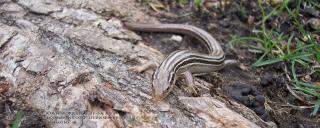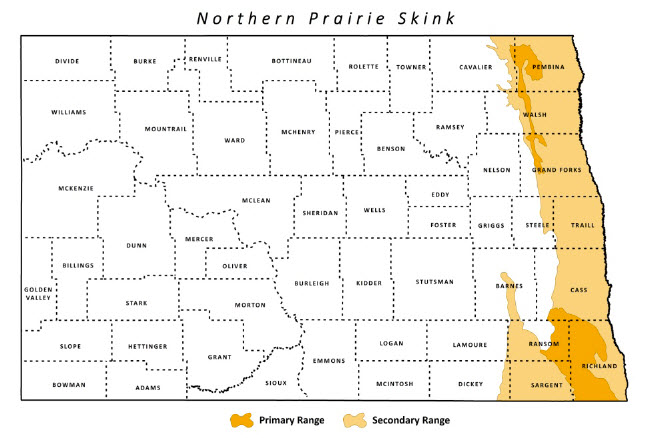
Northern Prairie Skink
| Scientific Name | Plestiodon septentrionalis |
|---|---|
| General Description | L 5-8”. Light gray-brown with several dark bands extending the length of the body. The belly is pale blue-gray. |
| Status | Year-round resident. |
| Abundance | Rare. |
| Primary Habitat | Sand dunes in grasslands. |
| Federal Status | No federal status. |
| Reason for Designation | Listed as Imperiled in Manitoba by NatureServe. This species has a rather small range in North America, limited to patchy segments of North Dakota, South Dakota, Minnesota, Wisconsin, Iowa, Nebraska, and Kansas. Little is known of this species in North Dakota. |
Locations and Conditions of Key Habitat
Preferred Habitat
Prairie skinks use open areas with grassy hillsides of soft soil and small, flat rocks. Burrow under stones or other objects on the ground. Skinks may increase in density as field age increases, as many as 200 adults per ha. Feed on grasshoppers, crickets, beetles, caterpillars, and spiders.
Key Areas and Conditions for Northern Prairie Skink in North Dakota
The largest population most likely occurs in the extreme southeastern grasslands of North Dakota, although records have come from the northern part of the state. Focus areas where this species occurs include the Sand Deltas and Beach Ridges.
Problems Which May Affect this Species
Habitat
Fragile sand habitat is at risk of destruction and/or degradation. The fragmentation of suitable habitat may hinder interconnectivity of populations, as movement of individual skinks is usually less than 100 meters.
Other Natural or Manmade Factors
It is unknown what effect pesticides, development, and other disturbance has on populations of prairie skinks.
Research and Survey Efforts
Current Research or Surveys
- North Dakota State University is surveying reptiles and amphibians in SE North Dakota.
Previous Research or Surveys
- Wheeler and Wheeler (1966) conducted a statewide survey of all amphibians and reptiles, as well as compiled existing records. The skinks were only found in the southeastern corner of the state.
- Hoberg and Gause (1992) recorded personal observations of prairie skinks in North Dakota.
- A compilation of all records in North Dakota by Jundt (2000) listed roughly 15 documentations of the prairie skink in the state.
Additional Research or Surveys Needed
Future efforts could include visual encounter surveys, but trapping may be the most productive method for determining presence.
Management Recommendations
- Prevent overgrowth by shrubs and trees to maintain openness in sand habitats.
- Restrict off-road vehicle use to preselected, less sensitive/lower quality areas.
Monitoring Plans
Currently no monitoring is taking place. Possible monitoring options could include school classes/programs including universities, the general public through the NDGFD incidental reporting system, or national monitoring initiatives such as PARC. Monitoring should be directed at all herptile species.
2005-2015 Progress
The Northern Prairie Skink maintains a level III Species of Conservation Priority. More information is needed to understand the status of this species in North Dakota. SWG T-44-R Amphibian and reptile surveys of southeastern North Dakota will provided more information on this species.

Note: A listing of works consulted when compiling the information on this page may be found in the 2015 State Wildlife Action Plan.
